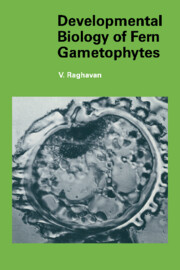Book contents
- Frontmatter
- Contents
- Preface
- Abbreviations
- 1 Introduction
- PART I THE BEGINNING
- PART II GROWTH AND MATURATION
- 6 Developmental physiology of gametophytes – the germ filament
- 7 Developmental physiology of gametophytes – induction of planar growth
- 8 Role of protein and nucleic acid synthesis in planar growth
- 9 Vegetative and reconstitutive growth of gametophytes
- PART III REPRODUCTIVE STRATEGIES
- PART IV DEVELOPMENTAL OPTIONS
- References
- Author index
- Subject index
7 - Developmental physiology of gametophytes – induction of planar growth
Published online by Cambridge University Press: 11 September 2009
- Frontmatter
- Contents
- Preface
- Abbreviations
- 1 Introduction
- PART I THE BEGINNING
- PART II GROWTH AND MATURATION
- 6 Developmental physiology of gametophytes – the germ filament
- 7 Developmental physiology of gametophytes – induction of planar growth
- 8 Role of protein and nucleic acid synthesis in planar growth
- 9 Vegetative and reconstitutive growth of gametophytes
- PART III REPRODUCTIVE STRATEGIES
- PART IV DEVELOPMENTAL OPTIONS
- References
- Author index
- Subject index
Summary
In the gametophytic generation of homosporous ferns, the germ filament represents a transient phase in anticipation of a major morphogenetic event, as, sooner or later, its terminal cell characteristically divides by an oblique or longitudinal wall to initiate planar morphology. The division wall also occasionally appears in the subterminal cells; in other cases, after the terminal cell is partitioned longitudinally, most of the cells in the filament may also follow suit. For purposes of discussion in this chapter, the essential mystery of transition of the germ filament to a planar gametophyte is considered to revolve around the orientation of the mitotic spindle in the terminal cell from a position parallel to the long axis of the cell to one perpendicular to it. This and the formation of the crosswall itself are engineered by a complex series of developmental processes of which we have only a rudimentary understanding.
Induction of planar growth in the fern protonema represents the beginning of a morphogenetic process that prepares it for the production of gametes. The major axioms governing morphogenesis in complex systems where a change in the plane of cell division initiates a change in the pattern of growth, can be analyzed with relative ease in the protonema.
- Type
- Chapter
- Information
- Developmental Biology of Fern Gametophytes , pp. 130 - 151Publisher: Cambridge University PressPrint publication year: 1989



